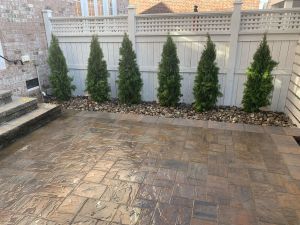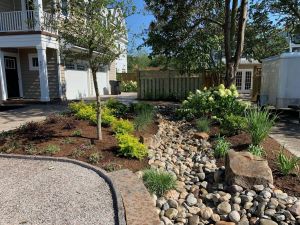1. Add a layer of mulch or pine straw to your landscaping beds to help protect your plants from the cold and reduce weeds.
-
- Mulch and pine straw are great ways to help insulate your plants against the cold temperatures of winter. They act as a barrier between the cold soil and the plants’ roots, helping to trap heat and prevent frost from coming into direct contact with the plants. Mulch and pine straw also retain moisture in the soil, helping to keep the plants hydrated even through the cold winter months. Additionally, mulch and pine straw can help protect the plants from strong winds, which can cause damage to the leaves and stem of the plants.

2. Plant evergreen shrubs and trees to provide year-round interest and color.
- There are a number of evergreen shrubs and trees that provide year round interest and color. Some popular evergreens include Boxwood, Blue Spruce, Juniper, Holly, and Arborvitae. These plants all provide a variety of colors and textures, as well as providing year-round interest in the landscape. For even more color, you could add flowering shrubs like Azaleas and Camellias. Whatever you choose, evergreen shrubs and trees are a great way to give your yard a lasting winter presence.

3. Install a rock garden to give your landscaping a unique look and add texture.
-
- A rock garden is a type of garden that uses rocks, pebbles, and stones as the main decorative element. The rocks are usually placed in a bed of soil and can be used to create different shapes, lines, or patterns. Rock gardens are often planted with low-maintenance and drought-tolerant plants that thrive in dry, rocky soils. Rock gardens are a great way to add texture and interest to a landscape and can also be used to create a peaceful and relaxing atmosphere.

4. Add a few bright touches with winter-blooming plants such as pansies, cyclamen, and hellebores.
-
- Adding winter-looking plants to your garden is a great way to bring life and beauty to your outdoor space during the colder months. They can provide a great source of color and texture, making your garden look more vibrant and inviting. Additionally, winter-looking plants are often hardy, so they can withstand harsher weather and last through the winter. Finally, some winter-looking plants can even provide food for wildlife, such as berries for birds, which can be a great way to attract wildlife to your garden and make it a more enjoyable place to be.

5. Incorporate different lighting options such as path lights, spotlights, and string lights to create a cozy atmosphere for outdoor entertaining.
-
- Winter can be a great time to enjoy outdoor lighting! There are a variety of options for outdoor lighting during the winter season, from festive string lights to cozy firepits. If you are looking for something to brighten up your outdoor space, consider installing some LED lights, which are energy efficient and offer a warm glow. If you want to create a more festive atmosphere, string lights or lanterns can be hung from tree branches or around your patio. Firepits are also a great way to create warmth and light while adding a cozy ambiance. With a little bit of imagination, you can create the perfect outdoor lighting set up for the winter season.

Winter is a great time to add some extra colour and life to your landscaping! You can create a winter wonderland in your garden by planting evergreen shrubs and trees, adding festive decorations, or creating a living mulch with colourful plants for a pop of colour. You can also consider adding a water feature to your garden – a bird bath or fountain will attract wildlife and create a beautiful focal point for your outdoor space. With a little bit of planning and effort, you can make your landscape look lively and inviting during the cooler months of the year.

